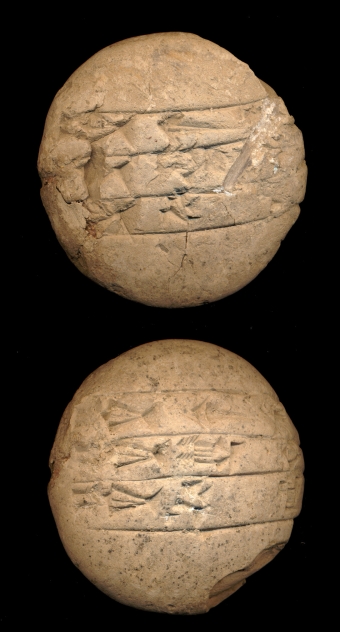Old Babylonian Exercises

LoC 35. Lentil-shaped (Type IV) exercise. The text on the obverse (a list of meat cuts) is repeated on the reverse. © Library of Congress, Washington DC.
Old Babylonian lexical exercises exist in various formats and are conventionally labeled as follows:
| P | Prism. Four- or six-sided clay object, with between one and three columns of text per side. Usually contains an entire composition |
| I | Large tablet. Multi-column tablet; four to six columns per side. Usually contains an entire composition. |
| II | Teacher-student exercise. The left column on the obverse contains a model text of ten to twenty lines by a teacher, with space to the right for one to three columns for the student to copy the model. The reverse contains four to six columns of text from a previously studied composition. |
| III | Single column exercise. Ten- to twenty-line extract from a composition in a single column that continues from obverse to reverse (rare). |
| IV | Lentil. Round lentil-shaped tablet with a two- to four-line model text by the teacher, repeated by the pupil either below the model text or on the back of the lentil. |
Thousands of Old Babylonian exercise texts are known from the city of Nippur in Central Babylonia. They are the products of scribal schools, where pupils learned how to read and write, but also copied literary texts in Sumerian. The lexical texts belong to the first, elementary stage of this education.
The Teacher-Student exercises (or Type II) contain two different exercises: a new exercise, which the student copied from a model by the teacher, on the obverse, and another eercise that the student already knew by heart, to be copied on the reverse. Type II exercises, therefore, allow a reconstruction of the order in which various lexical texts were studied in the Old Babylonian scribal school. This curriculum was not strictly standardized, but there are general patternsthat may be summarized as follows:
| Category | Example | Purpose |
|---|---|---|
| Sign Exercises | Syllable Alphabet A | Practice basic signs |
| Word Lists | Ura (thematic lists) | Acquire Sumerian vocabulary |
| Advanced lists | Diri (compound signs)
Izi (acrographic list) |
Deepen knowledge of Sumerian writing and vocabulary |
| Proverbs and Model Contracts | Sumerian Proverb Collections | Practice Sumerian writing and vocabulary skills in sentences |
| Literary Texts | Hymn to King Lipit-Eštar | Utilize literacy skills to learn about Sumerian heritage |
There is a general progression from simple to complex, and from shorter to longer exercise units.
27 Dec 2019Further reading
- Veldhuis, Niek C. 1997 Elementary Education at Nippur. The Lists of Trees and Wooden Objects. PhD Dissertation, University of Groningen. Download [http://irs.ub.rug.nl/ppn/30177613X].
Niek Veldhuis
Niek Veldhuis, 'Old Babylonian Exercises', Digital Corpus of Cuneiform Lexical Texts, The DCCLT Project, 2019 [http://oracc.museum.upenn.edu/dcclt/lexicalliststypology/exercises/oldbabylonian/]